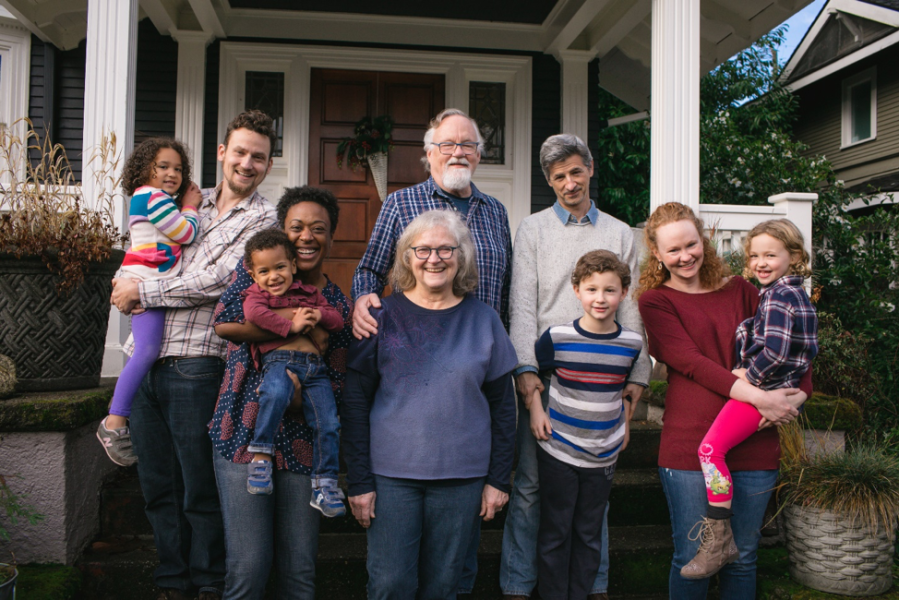By Catherine (Cay) Crowley, PhD
Interrupting Privilege Alum
I continue on a journey to become a better grandmother to all my grandchildren. I want for my mixed-race grandkids to have the same opportunity and the same treatment as our White children and grandchildren have had. I want them to be able to walk in our neighborhood without causing a stir.
 I am aware that progress on racism has been made in my lifetime. My son Patrick would not have been able to marry Erika until Loving v Virginia ended the ban of interracial marriages in 1967. Our kids attended integrated schools. But the progress has been limited and not nearly enough. Though legal slavery ended with Lincoln and the Civil War over 150 years ago, our Black citizens have been discriminated against through institutions like Jim Crow laws, redlining, and other efforts to marginalize them, deny them the ability to accumulate wealth, and to walk in the world with dignity. I have thought I was color blind, I thought we did pretty well at raising tolerant adults. The picture speaks to that success.
I am aware that progress on racism has been made in my lifetime. My son Patrick would not have been able to marry Erika until Loving v Virginia ended the ban of interracial marriages in 1967. Our kids attended integrated schools. But the progress has been limited and not nearly enough. Though legal slavery ended with Lincoln and the Civil War over 150 years ago, our Black citizens have been discriminated against through institutions like Jim Crow laws, redlining, and other efforts to marginalize them, deny them the ability to accumulate wealth, and to walk in the world with dignity. I have thought I was color blind, I thought we did pretty well at raising tolerant adults. The picture speaks to that success.
But when I am honest with myself I know I harbor deep seated racial biases. How do I respond when a young black man in a hoody walks toward me on the street or sits by me when I was still taking buses? Do I clutch my purse? Do I put my bag of market produce on the seat next to me? I have experimented with engaging the kid in conversation instead of distancing myself. The young man usually is wary at first but then seems to welcome conversing with me. I try to put myself in his shoes, thinking about the harm done by clutching my purse instead of being warmly engaged. Flash forward to the last few months. How many deaths of Black people have there been at the hands of police? My reactions were negative. Another death. Another abuse of power/privilege/position. But I am appalled that I was not outraged at the deaths of Aubrey or Breonna or George. I have become inured to how horrific these murders are…how frequently they happen and how little has been done to prevent these needless deaths. I am appalled at my failure to react more strongly. Where did my humanity go? I am appalled at myself.
Recently, Erika, Patrick and their kids attended the Seattle Children’s March. My husband and I opted to stay home so as to not risk the trump virus. I wish we had attended. Organized and managed by Black youths, ten demands were presented. The demands sound familiar to these 72 year old ears: fund education for schools equally, hire teachers who look like the students in the school, end police violence toward Black citizens, close the juvenile jails and instead provide more social and health support. Erika and Patrick were moved and inspired by the march. I am too. It is for the youth, passionate, articulate and courageous to work for these changes. It is up to us to support, encourage and ensure these changes.
That is easier said than done. I look at my precious grandson. He is cute as a button, smart as a whip, verbally precocious and bold physically and socially. He attended his first antiracist demonstration.

By the age of ten people will begin to treat him differently, react to him in fear, distance themselves. He will have to dress and behave in a way to avoid being harmed. His parents and I will have to worry if he will make it home from his first solo jog alive. His sister is equally cute, smart, precocious and dignified. In a very few years she will take her first driving lesson. Will that first driving lesson consist of learning to turn off the car, produce her credentials, put the keys on top of the car, raise her hands, and be polite when she is stopped by a cop? We have only a few years to reverse this reality for them. I admit I get frozen in my discouragement. I urge us all to try to do our part, to do better: on a daily basis, work to treat all people respectfully regardless of age, of color, of gender. Each of us can identify some institution, some law, some corporate policy that perpetuates racial discrimination. Each of us can commit to effect change. If you are in education, work to hire more educators of color, stop criminalizing school behavioral infractions, expect and encourage academic achievement for all children regardless of color. If you work in real estate or provide mortgages stop discriminating against people of color. Please, think of what you can do to effect change. If you cannot find a policy or procedure to change, donate to nonprofits that can result in change. Think of scholarships or programs designed for black students. Vote for people who will strive to make America anti-racist.
Roll up your sleeves. Do something. Look inside and see your own biases and work to change them.
Thank you.



